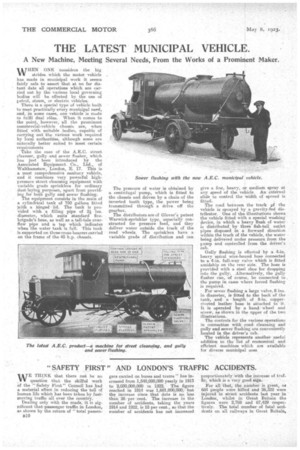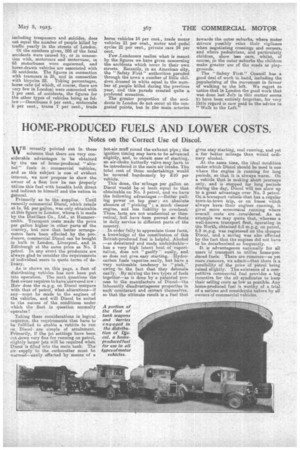THE LATEST MUNICIPAL VEHICLE.
Page 12

Page 13

If you've noticed an error in this article please click here to report it so we can fix it.
wHEN ONE considers the big
strides which the motor vehicle has made in municipal work it seems fairly safe to assert that at no far distant date all operations which are can ried out by the various local governing bodies will be effected by the Use of petrol, steam, or electric vehicles.
There is a special type of vehicle built to meet practically every municiRal need, and, in some cases, one vehicle is made to fulfil dual roles, When it comes to the point, however; all the prominent commerci;1-vehicle chassis are, when fitted with. suitable bodies, capable of carrying out the various work required by local authorities, although some are naturally better suited to meet certain requirements
'Take the case of the A.E.G. street cleanser, gully and sewer flusher, which has just been introduced by the Associated Equipment. Co., Ltd., of Walthamstow, London, E. 17. This is a. most comprehensive sanitary vehicle, and it combines very powerful highpressure street cleansing equipment with variable grade sprinklers for ordinary dust-laying purposes, apart from providing .for bath gully and sewer flushing.
The equipment consists in the main of a cylindrical tank of 750 gallons fitted nith a hinged lid. The tank is provided with a filling pipe of 2i ins. diameter, which suits standard firebrigade's hose, as well as a tell-tale overflow pipe anal a tap which indicates when the water tank is full. This tank is supported on three cross-bearers carried on the frame of the 45 h.p. chassis.
The pressure of water is obtained by a centrifugal pump, which is fitted to the chassis and driven by a chain of the inverted tooth type, the power being transmitted through a drive off the gearbox.
The distributors are of Glover's patent Warwick-sprinkler type, especially constructed for pressure feed, and they deliver water outside the track of the road wheels. The sprinklers have .a variable grade of distribotion and can give a fine, heavy, or medium spray at any speed of the vehicle. An extevrnat slide to control the width of spread is fitted.
The road between the track pf the vehicle is sprayed by a gravity-fed distributor. One of the illustrations shows the vehicl,e fitted with a special washing device, in which a heavy flush of wateris distributed by three fish-tail outlet pipes disposed in a forward direction within the track of the vehicle, the water being delivered under pressure, from the pump and cantrolled from the driver's cab.
Gully flushing is effected by a .4-in. heavy spiral wire-bound hose connected to a 4-in. full-way valve which is fitted amidship on the rear side. The hose is provided with a steel shoe for dropping into the gu1l3n Alternatively, the gully fineher can, of course, be connected to the pump in cases where forced flushing is required.
For sewer flushing a large valve, 8 ins. in diameter, is fitted to the back of the tank, anda 'length of 8-in. capperriveted leather hose is attached to it. It is operated by a hand Wheel and screw, as shown in the upper of the two illustrations.
The controls far the various Operations in connection with roth cleansing and gully and sewer flushing are conveniently located in the driver's cab.
The vehicle represents another useful addition to the list a economical and efficient machines which are available for diverse municipal rises.
including trespassers and suicides, does not equal the number of people killed by traffic yearly in the streets of London.
Of the numbers given, 505 of the fatal accidents were caused by, or in connection with, motorcars and motorvane, in 63 motorbuses were concerned, and horse-drawn vehicles are associated with 59 accidents. The figures in connection with tramcars is 35, and in connection with bicycles 22. Taking percentages, horse cabs {of which, of course, there are very few in London) were connected with 1 per cent, of accidents, the figures for the other types of vehicles being as follow :—Omnibuses 6 per cent., motorcabs 6 per cent., trains 7 per cent., trade horse vehicles 14 per cent., trade motor vehicles 21 per cent., motor and pedal cycles 21 per cent., private cars 24 per cent.
Few Londoners realize what is meant by the figures we have given concerning the accidents which occur in their own streets. Recently, in an American city, the "Safety First" authorities _paraded through the town a number of little children dressed in white equal to the number of people killed during the previous year, and this parade created quite a profound sensation.
The greater proportion of the accidents in London do not occur at the congested points, but in the main arteries towards the outer suburbs, where motor drivers possibly relax their vigilance when negotiating crossings and corners, and where pedestrians, and particularly children, show less care, whilst, of iii n the outer suburbs the children make greater use of the roads as playgrounds. " The "Safety Fir& " Council has a good deal of work in hand, including the popularizing of the movement in favour of walking to the left. We regret to notice that in London the good work that was done last July in this matter seems b have been entirely forgotten, for very little regard is now paid to the advice to "Walk to the Left.'


































